Industrial Structure Transformation and Layout Optimization of Beijing-Tianjin-Hebei Region under Carbon Emission Constraints
Abstract
1. Introduction
2. Materials and Methods
2.1. Method for Calculating Carbon Emissions
2.2. Industrial Carbon Entropy and Regional Carbon Entropy Model
2.2.1. Industrial Carbon Entropy
2.2.2. Regional Carbon Entropy
2.3. Models to Measure the Carbon Efficiency of Industry
2.3.1. Super-Efficiency Data Envelopment Analysis (DEA) Model
2.3.2. Two-Stage SuperSBM Model
2.3.3. Carbon Efficiency Model
2.4. System of Indicators to Measure the Carbon Efficiency of Industry
2.5. Overview of the Study Region and Data Sources
2.5.1. Study Region
2.5.2. Data Sources
3. Results
3.1. Evolutionary Characteristics of the Structure and Distribution of Industries Based on Carbon Entropy
3.1.1. Changes in Industrial Structure
3.1.2. Spatial Distribution of Industrial Types
3.2. Evolutionary Characteristics of the Structure and Distribution of Industries Based on Carbon Efficiency
3.2.1. Status of Industries
3.2.2. Spatial Layout of Industries
4. Discussion
4.1. Optimization and Regulation Strategy for Industrial Structure Transformation
4.1.1. High-Efficiency Industries Whose Development Should Be Prioritized
4.1.2. Medium-Efficiency Industries Whose Development Should Be Prioritized
4.1.3. High-Efficiency Industries Whose Development Should Be Moderate
4.1.4. Medium-Efficiency Industries Whose Development Should Be Moderate
4.1.5. Low-Efficiency Industries Whose Development Should Be Moderate
4.1.6. High-Efficiency Industries Whose Development Should Be Restricted
4.1.7. Medium-Efficiency Industries Whose Development Should Be Restricted
4.1.8. Low-Efficiency Industries Whose Development Should Be Restricted
4.2. Optimization and Regulation Path of the Industrial Spatial Layout
4.2.1. High-Efficiency Areas Whose Development Should Be Prioritized
4.2.2. High-Efficiency Areas Whose Development Should Be Moderate
4.2.3. Low-Efficiency Areas Whose Development Should Be Prioritized
4.2.4. Low-Efficiency Areas Whose Development Should Be Moderate
4.2.5. Low-Efficiency Areas Whose Development Should Be Restricted
5. Conclusions
Author Contributions
Funding
Data Availability Statement
Conflicts of Interest
References
- Li, L.; Lei, Y.; Wu, S.; He, C.; Chen, J.; Yan, D. Impacts of City Size Change and Industrial Structure Change on CO2 Emissions in Chinese Cities. J. Clean. Prod. 2018, 195, 831–838. [Google Scholar] [CrossRef]
- Zhou, P.; Ang, B.W.; Han, J.Y. Total Factor Carbon Emission Performance: A Malmquist Index Analysis. Energy Econ. 2010, 32, 194–201. [Google Scholar] [CrossRef]
- Yu, B.; Li, X.; Qiao, Y.; Shi, L. Low-carbon Transition of Iron and Steel Industry in China: Carbon Intensity, Economic Growth and Policy Intervention. J. Environ. Sci. 2015, 28, 137–147. [Google Scholar] [CrossRef]
- Rootzen, J.; Johnsson, F. CO2 Emissions Abatement in the Nordic Carbon-intensive Industry–An End-game in Sight? Energy 2015, 80, 715–730. [Google Scholar] [CrossRef]
- Lin, B.; Moubarak, M. Decomposition Analysis: Change of Carbon Dioxide Emissions in the Chinese Textile Industry. Renew. Sustain. Energy Rev. 2013, 26, 389–396. [Google Scholar] [CrossRef]
- Elliott, R.J.; Shanshan, W.U. Industrial Activity and the Environment in China: An Industry-Level Analysis. China Econ. Rev. 2008, 19, 393–408. [Google Scholar]
- He, X.G.; Zhang, Y.H. Influence Factors and Environmental Kuznets Curve Relink Effect of Chinese Industry’s Carbon Dioxide Emission—Empirical Research Based on STIRPAT Model with Industrial Dynamic Panel Data. China Ind. Econ. 2012, 1, 26–35. (In Chinese) [Google Scholar]
- Deng, J.X.; Liu, X.; Wang, Z. Characteristics Analysis and Factor Decomposition Based on the Regional Difference Changes in China’s CO2 Emission. J. Nat. Resour. 2014, 29, 189–200. (In Chinese) [Google Scholar]
- Yuan, C.W.; Zhang, S.; Jiao, P.; Wu, D.Y. Temporal and Spatial Variation and Influencing Factors Research on Total Factor Efficiency forTransportation Carbon Emissions in China. Resour. Sci. 2017, 39, 687–697. (In Chinese) [Google Scholar]
- Xie, Z.X.; Qin, Y.C.; Shen, W.; Rong, P.J. Efficiency and Impact Factors of Low Carbon Economic Development in China. Econ. Geogr. 2017, 13, 88–93. (In Chinese) [Google Scholar]
- Zhang, X.H.; Wang, Z.R. Analysis of Influence Factors of Carbon Emission in China’s Industrial Department. J. Ind. Technol. Econ. 2013, 5, 123–129. (In Chinese) [Google Scholar]
- Pang, R.Z.; Li, P.; Lu, Y.G. Study on “New-type” Industrialization Growth Performance and Its Factors during the Transitional Period—Based on “New-type” Industrialization Total Factor Productivity. China Ind. Econ. 2011, 4, 64–73. (In Chinese) [Google Scholar]
- Yan, X.; Fang, Y.P. CO2 Emissions and Mitigation Potential of the Chinese Manufacturing Industry. J. Clean. Prod. 2015, 103, 759–773. [Google Scholar] [CrossRef]
- Ouyang, X.; Lin, B. An Analysis of the Driving Forces of Energy-related Carbon Dioxide Emissions in China’s Industrial Sector. Renew. Sustain. Energy Rev. 2015, 45, 838–849. [Google Scholar] [CrossRef]
- Faye, D. Reducing CO2 Emissions: A Comparative Input-Output Study for Germany and the UK; Proops, J.L.R., Faber M. Wagenhals, G., Eds.; Springer: Berlin, Germany, 1992. [Google Scholar]
- Schipper, L.; Murtishaw, S.; Khrushch, M. Carbon Emissions from Manufacturing Energy Use in 13 IEA Countries: Long-term Trends through 1995. Energy Policy 2001, 29, 667–688. [Google Scholar] [CrossRef]
- Lin, S.J.; Lu, I.J.; Lewis, C. Grey Relation Performance Correlations among Economics, Energy Use and Carbon Dioxide Emission in Taiwan—ScienceDirect. Energy Policy 2007, 35, 1948–1955. [Google Scholar] [CrossRef]
- Chao, W.; Jin, Z.; Yu, B.; Xi, C.; Fan, Z. Measuring Carbon Emission Performance of Industrial Sectors in the Beijing-Tianjin-Hebei Region, China: A Stochastic Frontier Approach. Sci. Total Environ. 2019, 685, 786–794. [Google Scholar]
- Zhang, Y.; Wang, Y.; Hou, X. Carbon Mitigation for Industrial Sectors in the Jing-Jin-Ji Urban Agglomeration, China. Sustainability 2019, 11, 6383. [Google Scholar] [CrossRef]
- Ke, J.; Zheng, N.; Fridley, D.; Price, L.; Zhou, N. Potential Energy Savings and CO2 Emissions Reduction of China’s Cement Industry. Energy Policy 2012, 45, 739–751. [Google Scholar] [CrossRef]
- Shi, Y.; Chen, L.; Liu, Z.; Yan, J.; Hu, J. Analysis on the Carbon Emission Reduction Potential in the Cement Industry in Terms of Technology Diffusion and Structural Adjustment: A Case Study of Chongqing. Energy Procedia 2012, 16, 121–130. [Google Scholar] [CrossRef]
- Cao, Z.; Shen, L.; Liu, L.; Zhong, S.; Liu, G. A Bottom-up Analysis of CO2 Emission Intensity of Chinese Cement Industry. Resour. Sci. 2017, 39, 2344–2357. [Google Scholar]
- Wang, Y.; Gu, S.P. Analysis of Electricity Carbon Footprint and Its Ecological Stress in China from 2006 to 2015. Acta Sci. Circumst. 2018, 38, 4873–4878. (In Chinese) [Google Scholar]
- Liu, H.; Liu, Y.; Xu, X. Optimization of Industrial Structure and Layout in Chengdu-Chongqing Economic Zone Based on Environmental Efficiency Evaluation. Resour. Environ. Yangtze Basin 2012, 9, 1058–1066. (In Chinese) [Google Scholar]
- Cook, W.D.; Liang, L.; Zha, Y.; Zhu, J. A Modified Wuper-efficiency DEA Model for Infeasibility. J. Oper. Res. Soc. 2017, 60, 276–281. [Google Scholar] [CrossRef]
- Feng, D.; li, J. Research of the Carbon Dioxide Emission Efficiency and Reduction Potential of Cities in the Beijing-Tianjin-Hebei Region. Resour. Sci. 2017, 5, 978–986. (In Chinese) [Google Scholar]
- Wang, Z.F.; Du, Y.Y. Spatial-temporal Differences and Influencing Factors of Carbon Emission Efficiency in Hunan Province Based on SBM-DEA Model. Sci. Geogr. Sin. 2019, 39, 797–806. (In Chinese) [Google Scholar]
- Jiang, S.R.; Tan, X.; Shi, L.; Ma, Z. Industrial Air Pollution Emission Efficiency in Beijing-Tianjin-Hebei and Its Surrounding Areas-based on Three Stage DEA Model. J. Arid Land Resour. Environ. 2019. [Google Scholar] [CrossRef]
- Yuan, K.H.; Mei, Y.; Chen, Y.R.; Lan, M.T. Temporal and Spatial Evolution and Influencing Mechanism of Construction Land Intensive Utilization on Carbon Emissions Efficiency in China. Resour. Sci. 2017. (In Chinese) [Google Scholar] [CrossRef]
- Zhu, C.G.; Zhang, C.M.; Qiu, F.D.; Yuan, H.; Ma, X.D. Transformation of Industrial Structure and Layout Optimization based on Low-Carbon Economy in Xuzhou Metropolitan Area. Econ. Geogr. 2017, 37, 126–135. (In Chinese) [Google Scholar]
- Guo, T.Y.; Xu, Y.; Wang, Z.Q. The Analyses of Metropolitan Efficiencies and Their Changes in China Based on DEA and Malmquist Index Models. Acta Geogr. Sin. 2009, 64, 408–416. (In Chinese) [Google Scholar]
- Yan, Y.F. Carbon Footprint’s Trends, Space, Industrial Distribution in Beijing-Tianjin-Hebei Region. Res. Econ. Manag. 2016, 37, 75–81. (In Chinese) [Google Scholar]
- Sun, L.W.; Han, Y.; Du, J. Influencing Factors of Carbon Footprint of High Energy Consumption Industry in Beijing-Tianjin-Hebei: Based on De Bruyn Model. Technol. Econ. 2019, 38, 86–92. (In Chinese) [Google Scholar]
- Wang, S.; Huang, Y.; Zhou, Y. Spatial Spillover Effect and Driving Forces of Carbon Emission Intensity at The City Level in China. J. Geogr. Sci. 2019, 29, 231–252. [Google Scholar] [CrossRef]
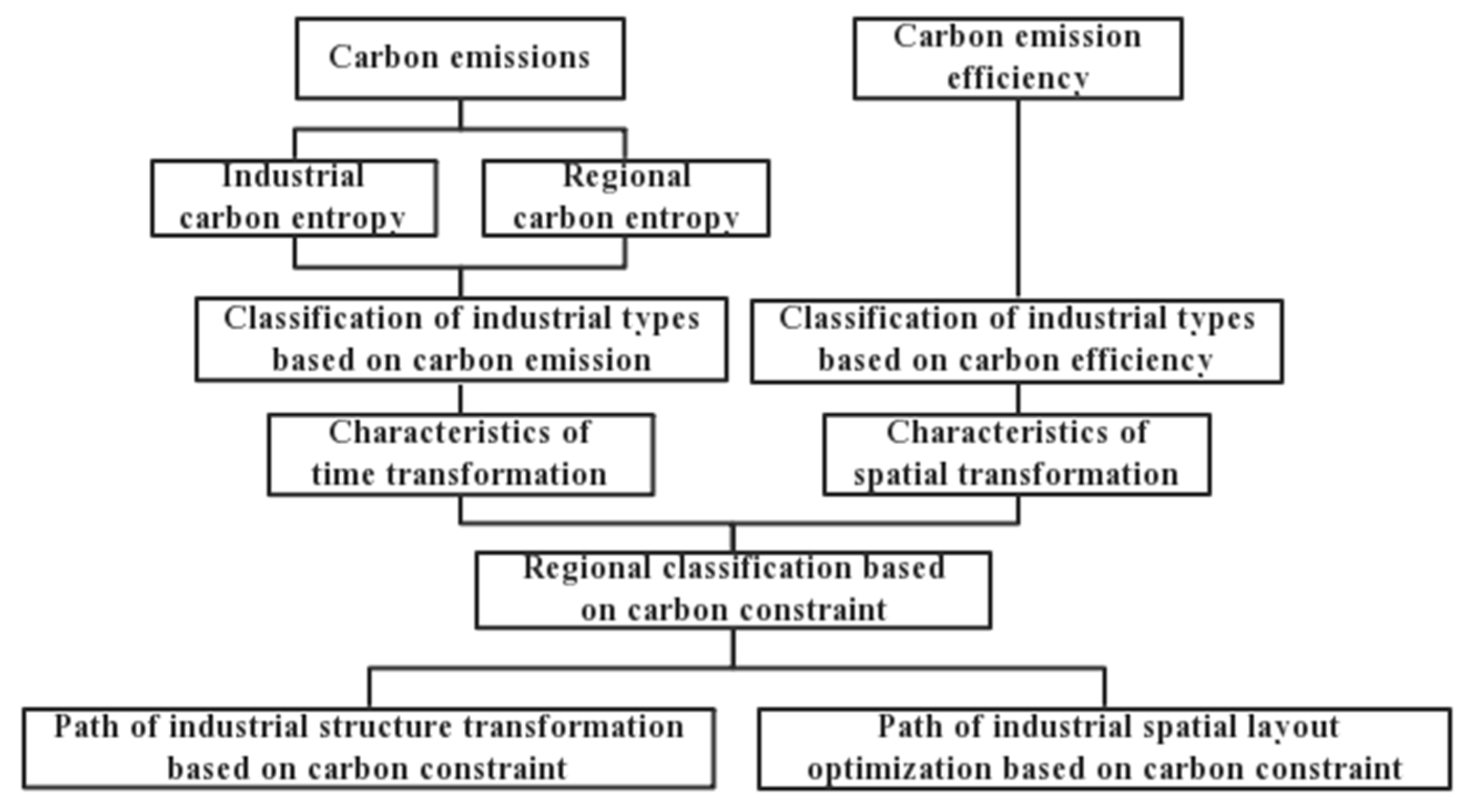
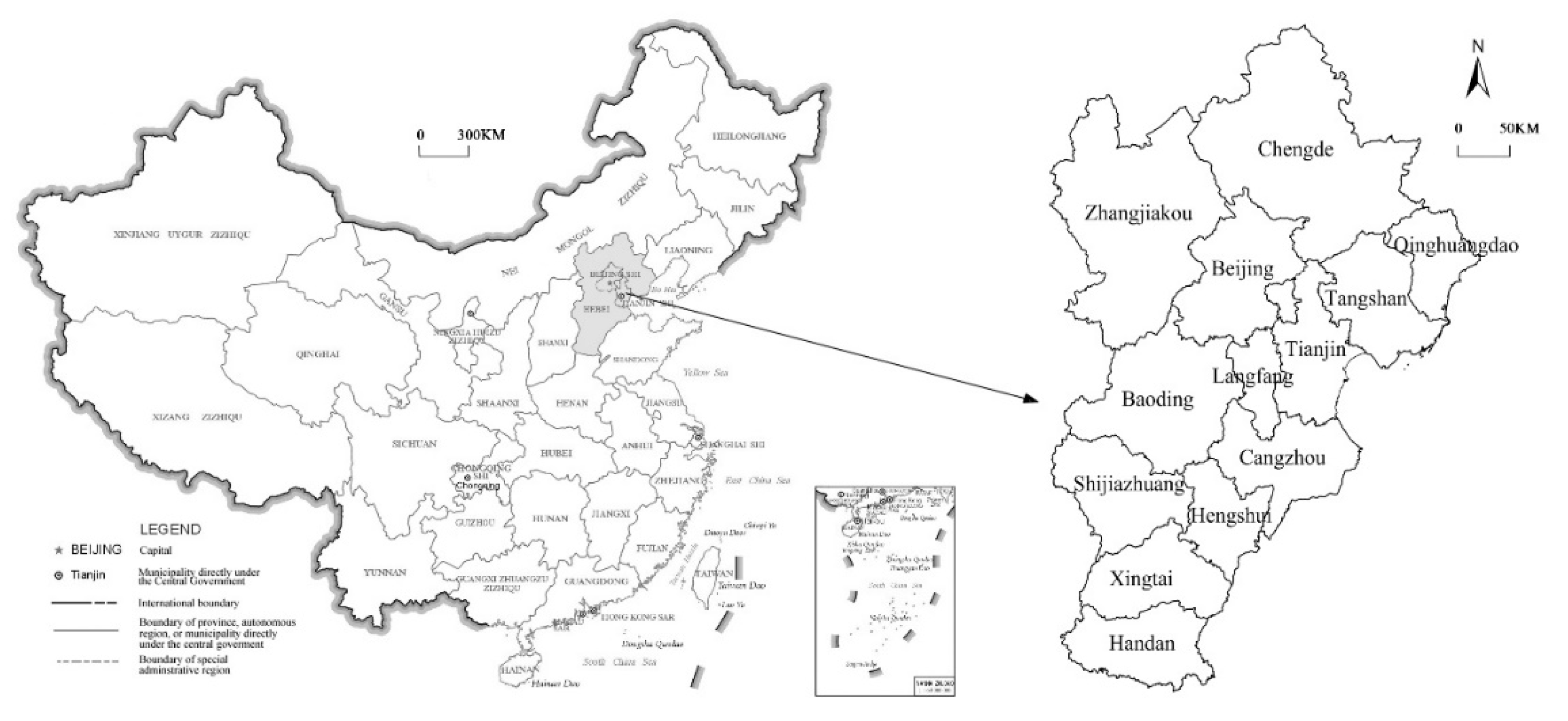
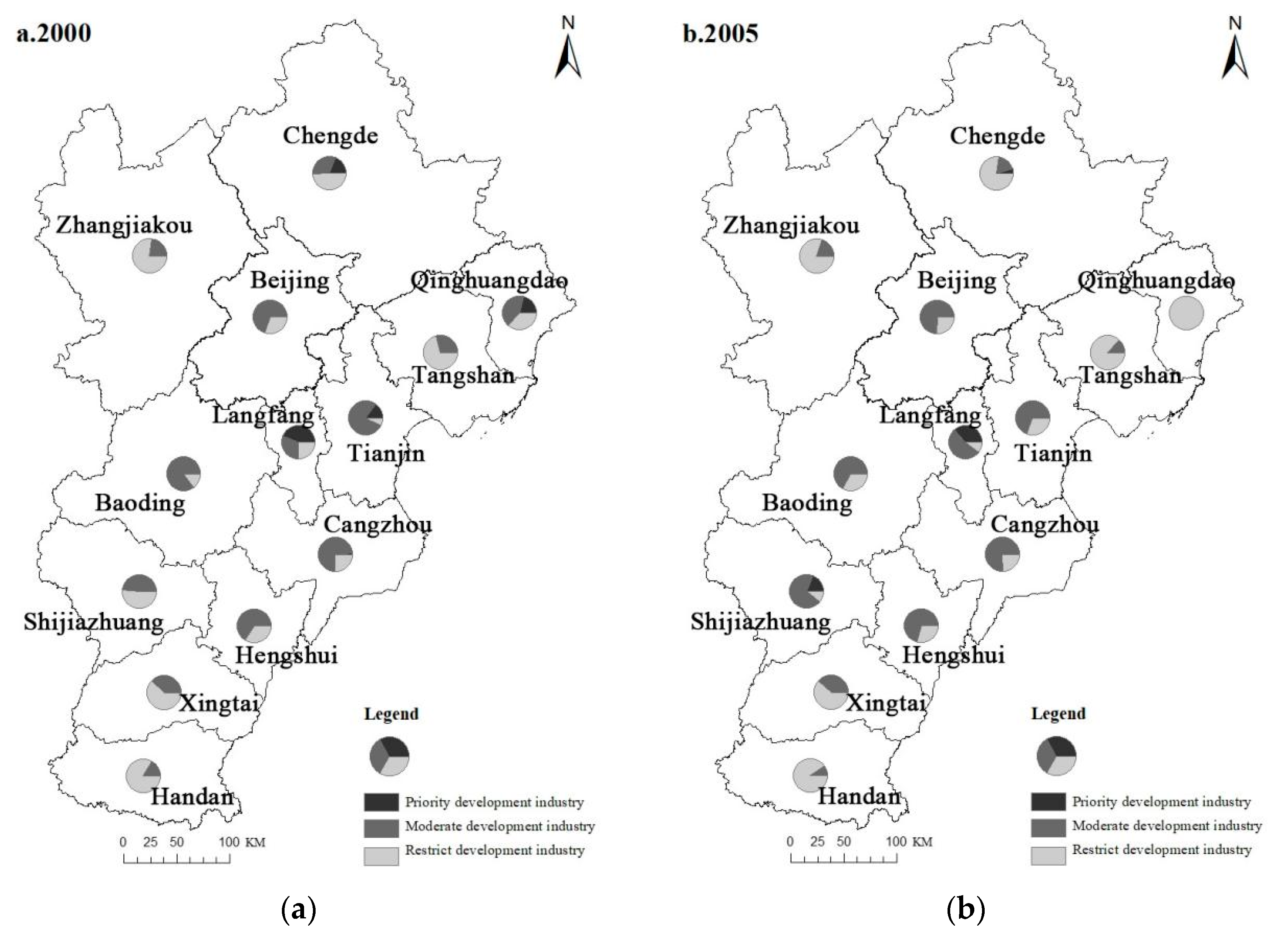
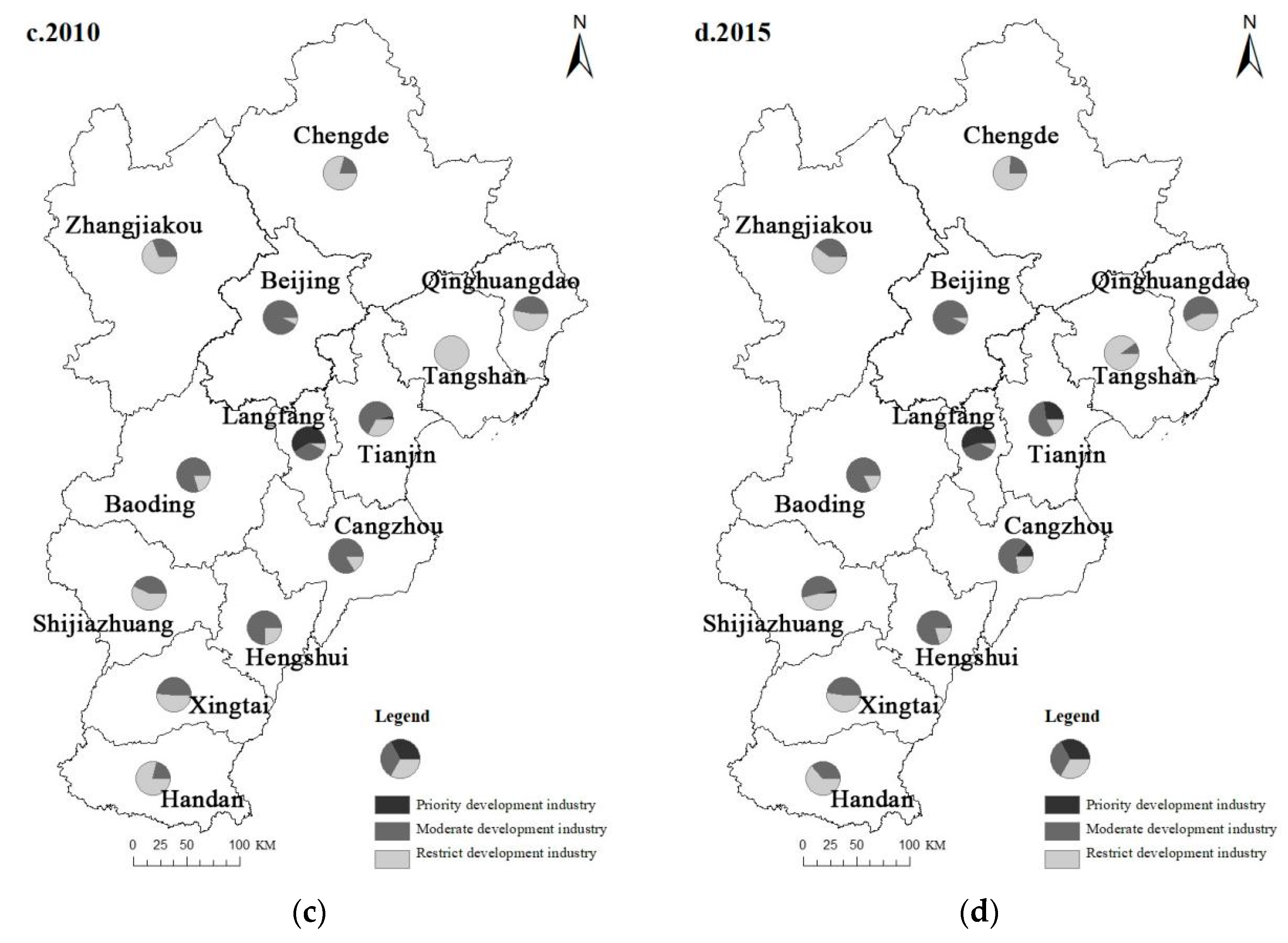
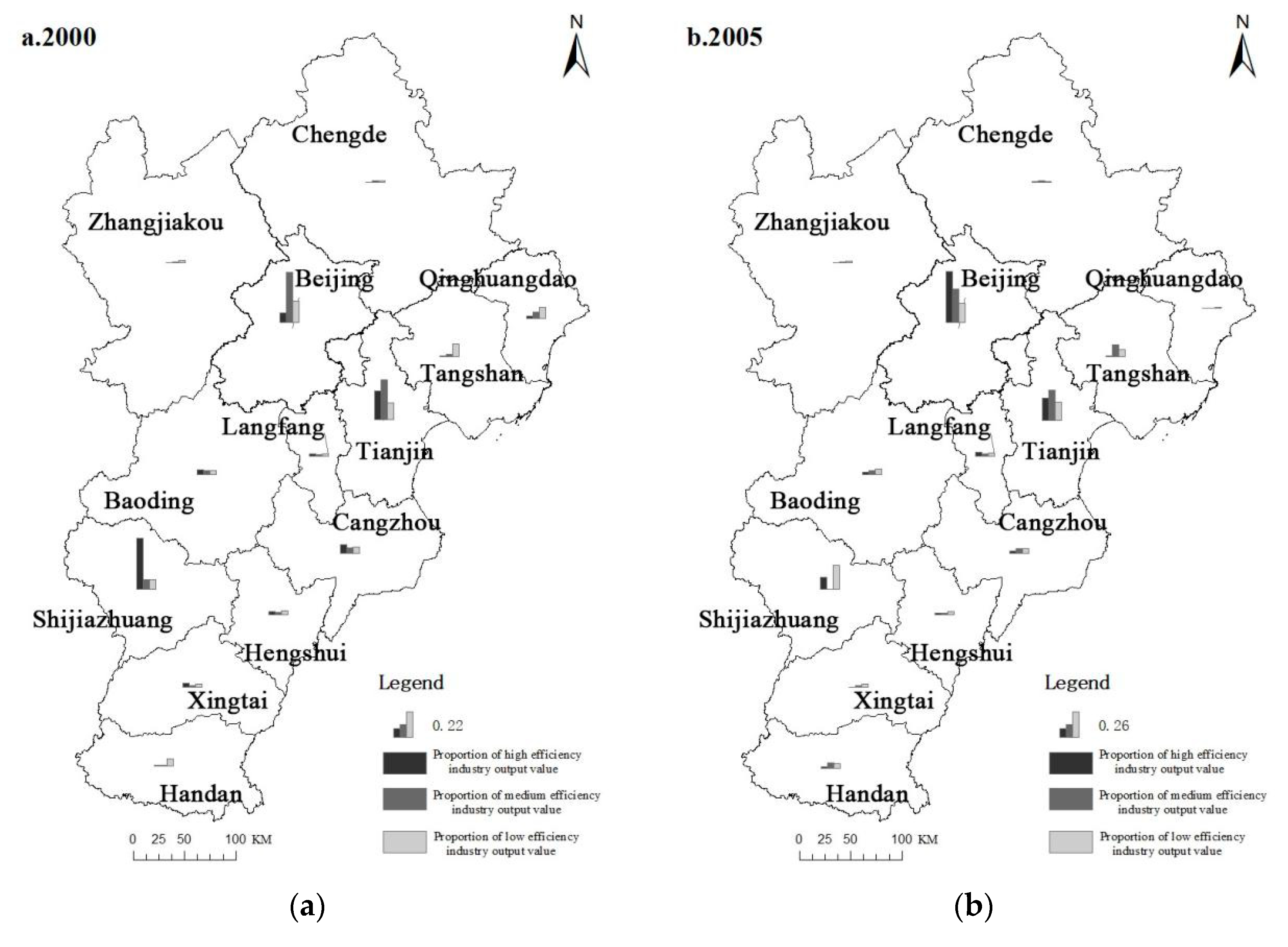
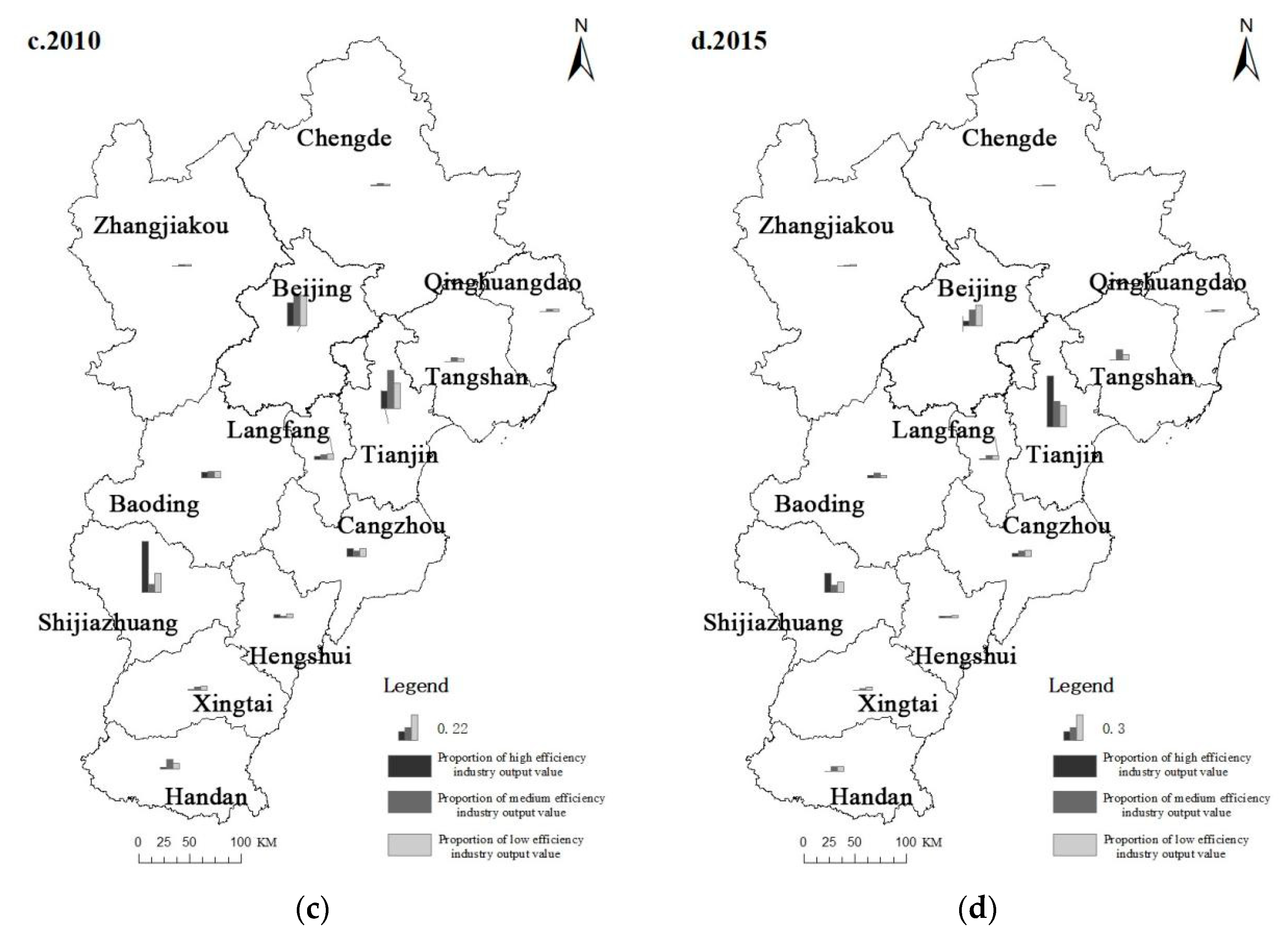
| Indicator Type | Primary Indicators | Secondary Indicators |
|---|---|---|
| Input index | Economic factor input | Industrial capital stock |
| Labor factor input | Industrial employees | |
| Energy factor input | Industrial power consumption | |
| Output indicators | Expected output | Industrial added value |
| Unexpected output | Industrial CO2 emissions |
| Trade Name | 2000 | 2005 | 2010 | 2015 |
|---|---|---|---|---|
| Food processing industry | 77,700.79 | 234,606.07 | 197,361.99 | 251,514.91 |
| Food manufacturing industry | 69,060.72 | 101,267.43 | 130,896.02 | 178,171.98 |
| Beverage manufacturing industry | 60,473.34 | 91,906.06 | 105,986.36 | 88,622.53 |
| Textile industry | 260,835.76 | 294,043.95 | 442,889.68 | 389,186.00 |
| Clothing and other fiber products manufacturing industry | 43,917.82 | 101,399.27 | 140,659.71 | 173,499.65 |
| Leather, fur, down and its products | 9028.51 | 25,690.95 | 33,637.00 | 43,404.81 |
| Wood processing and bamboo, rattan, palm grass products industry | 20,163.01 | 79,863.10 | 55,051.32 | 436,370.49 |
| Furniture manufacturing industry | 66,090.63 | 103,610.95 | 371,318.79 | 130,679.04 |
| Paper and paper products industry | 142,235.01 | 267,732.83 | 305,744.92 | 348,636.36 |
| Reproduction of recording media in printing industry | 48,864.40 | 59,803.40 | 139,877.53 | 83,187.72 |
| Petroleum processing and coking industry | 592,759.61 | 418,500.49 | 627,472.19 | 596,347.23 |
| Chemical raw materials and chemical products manufacturing industry | 1,080,111.51 | 1,301,442.14 | 1,761,649.90 | 1,789,613.33 |
| Pharmaceutical manufacturing industry | 166,833.64 | 83,235.11 | 311,581.66 | 266,080.18 |
| Rubber and plastic products industry | 105,785.97 | 266,257.21 | 402,492.34 | 432,138.48 |
| Non-metallic mineral products industry | 788,486.32 | 860,061.42 | 1,241,886.33 | 1,274,621.34 |
| Ferrous metal smelting and rolling processing industry | 2,202,149.45 | 3,701,548.49 | 6,797,725.29 | 6,978,381.54 |
| Nonferrous metal smelting and rolling processing industry | 112,637.82 | 110,285.96 | 236,548.97 | 258,485.72 |
| Metal products industry | 146,717.02 | 239,833.99 | 461,505.05 | 758,596.88 |
| General machinery manufacturing industry | 148,340.99 | 241,266.10 | 515,364.99 | 358,520.99 |
| Special equipment manufacturing industry | 89,157.04 | 128,019.94 | 256,246.02 | 314,542.98 |
| Transportation equipment manufacturing industry | 111,001.25 | 222,684.46 | 461,913.71 | 658,431.47 |
| Electrical machinery and equipment manufacturing industry | 81,129.07 | 163,376.65 | 187,483.03 | 367,594.62 |
| Computer, communication and other electronics equipment manufacturing industry | 81,758.45 | 310,709.19 | 325,136.74 | 387,248.03 |
| Instrument culture, office machinery manufacturing industry | 11,106.51 | 21,165.91 | 24,781.64 | 19,553.03 |
| Electricity, gas and water production and supply industry | 1,204,666.64 | 2,204,944.93 | 3,556,635.93 | 3,523,852.08 |
| Industry Type | Meet Conditions | 2000 | 2005 | 2010 | 2015 |
|---|---|---|---|---|---|
| Priority development industry | ICQ > 1 and RCQ > 1 | 17, 24 | |||
| Moderate development industry | ICQ > 1 and RCQ < 1ICQ < 1 and RCQ > 1 | 1, 2, 3, 4, 5, 6, 7, 10, 14, 17, 18, 19, 20, 21, 22, 23, 24 | 1, 2, 3, 4, 5, 6, 10, 11, 13, 17, 18, 19, 20, 21, 22, 23, 24 | 1, 2, 3, 5, 6, 7, 11, 13, 14, 17, 18, 19, 20, 21, 22, 23, 24 | 1, 2, 3, 4, 6, 10, 11, 13, 18, 19, 20, 21, 22, 23 |
| Restrict development industry | ICQ < 1 and RCQ < 1 | 8, 9, 11, 12, 13, 15, 16, 25 | 7, 8, 9, 12, 14, 15, 16, 25 | 4, 8, 9, 10, 12, 15, 16, 25 | 5, 7, 8, 9, 12, 14, 15, 16, 25 |
| Trade Name | 2000 | 2005 | 2010 | 2015 |
|---|---|---|---|---|
| Food processing industry | 0.5908 | 0.2831 | 1.0000 | 0.2724 |
| Food manufacturing industry | 0.7707 | 0.8380 | 0.7288 | 0.1097 |
| Beverage manufacturing industry | 0.6343 | 0.6626 | 0.4899 | 0.4494 |
| Textile industry | 0.3131 | 0.4983 | 0.4255 | 0.7268 |
| Clothing and other fiber products manufacturing industry | 0.6614 | 0.2577 | 0.3964 | 0.7965 |
| Leather, fur, down and its products | 1.2302 | 1.0000 | 1.6366 | 1.0501 |
| Wood processing and bamboo, rattan, palm grass products industry | 1.1545 | 1.0711 | 1.0705 | 1.0002 |
| Furniture manufacturing industry | 1.0000 | 1.0000 | 0.2844 | 1.0000 |
| Paper and paper products industry | 0.3921 | 0.5725 | 0.6082 | 0.7586 |
| Reproduction of recording media in printing industry | 0.8942 | 0.9964 | 0.9604 | 0.9949 |
| Petroleum processing and coking industry | 1.0000 | 1.0000 | 1.0000 | 0.4662 |
| Chemical raw materials and chemical products manufacturing industry | 0.0757 | 0.2387 | 0.2688 | 0.2347 |
| Pharmaceutical manufacturing industry | 0.5269 | 1.0000 | 0.7560 | 0.5525 |
| Rubber and plastic products industry | 0.7376 | 0.2786 | 0.5414 | 0.7206 |
| Non-metallic mineral products industry | 0.1037 | 0.2742 | 0.2973 | 0.3426 |
| Ferrous metal smelting and rolling processing industry | 0.0371 | 1.0000 | 1.0000 | 1.0000 |
| Nonferrous metal smelting and rolling processing industry | 1.0000 | 1.0000 | 1.0000 | 1.0000 |
| Metal products industry | 0.4656 | 0.2872 | 0.3926 | 0.5794 |
| General machinery manufacturing industry | 0.5490 | 0.5579 | 0.4324 | 0.4567 |
| Special equipment manufacturing industry | 0.9125 | 0.7354 | 0.7174 | 0.6945 |
| Transportation equipment manufacturing industry | 0.7342 | 0.8279 | 1.0000 | 1.0000 |
| Electrical machinery and equipment manufacturing industry | 1.0000 | 0.5051 | 1.0000 | 0.6557 |
| Computer, communication and other electronics equipment manufacturing industry | 1.0000 | 1.0000 | 1.0000 | 0.9524 |
| Instrument culture, office machinery manufacturing industry | 1.0000 | 1.2138 | 1.3573 | 2.2199 |
| Electricity, gas and water production and supply industry | 0.0679 | 0.1409 | 0.1299 | 0.1868 |
| Average value | 0.6741 | 0.6896 | 0.7397 | 0.7288 |
Publisher’s Note: MDPI stays neutral with regard to jurisdictional claims in published maps and institutional affiliations. |
© 2021 by the authors. Licensee MDPI, Basel, Switzerland. This article is an open access article distributed under the terms and conditions of the Creative Commons Attribution (CC BY) license (http://creativecommons.org/licenses/by/4.0/).
Share and Cite
Chai, Y.; Lin, X.; Wang, D. Industrial Structure Transformation and Layout Optimization of Beijing-Tianjin-Hebei Region under Carbon Emission Constraints. Sustainability 2021, 13, 643. https://doi.org/10.3390/su13020643
Chai Y, Lin X, Wang D. Industrial Structure Transformation and Layout Optimization of Beijing-Tianjin-Hebei Region under Carbon Emission Constraints. Sustainability. 2021; 13(2):643. https://doi.org/10.3390/su13020643
Chicago/Turabian StyleChai, Yi, Xueqin Lin, and Dai Wang. 2021. "Industrial Structure Transformation and Layout Optimization of Beijing-Tianjin-Hebei Region under Carbon Emission Constraints" Sustainability 13, no. 2: 643. https://doi.org/10.3390/su13020643
APA StyleChai, Y., Lin, X., & Wang, D. (2021). Industrial Structure Transformation and Layout Optimization of Beijing-Tianjin-Hebei Region under Carbon Emission Constraints. Sustainability, 13(2), 643. https://doi.org/10.3390/su13020643




